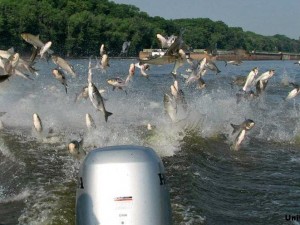By Phil Petersen
Live and learn can best describe our water safety and fighting Aquatic Invasive Species activity this summer. In the spring we learned that the State Game and Fish Protection Fund that holds our Boat Registration user fees had a $38.7M spending cap. While this legislature spending cap had never come into play until this year it did cut the number of Water Patrol Officers from 14 – we have had the last few years – to four. With help from Senator David Johnson and Representative Jeff Smith we were able to add six more officers in July when the new fiscal year started.
As the result of a July 23rd meeting with Governor Branstad and Lt. Governor Reynolds to explain the problem we are hopeful that the $38.7 M spending cap will not be a factor in the future. The legislature has established an interim study committee to examine how the user fees from the State Game and Fish Protection Fund are spent.
Foruntently, the Okoboji Protective Association had obtained a grant from the Dickinson County Water Quality Commission last fall to hire six college students for the summer to educate boaters about the threat from Aquatic Invasive Species. Iowa Lakeside Laboratory provided and housing and meals for the students. These six college students helped to replace the three DNR Water Patrol Officers and three Fisheries Bureau interns we have had for the past two summers.
JUMPING FISH
For several years we have felt we were isolated from the Silver Asian Carp (jumping fish) found in Illinois and Southeast Iowa rivers. We also thought we were protected by the Little Sioux River dam at Linn Grove. This summer the wide spread flooding on the Missouri river and its tributaries provided a carp swim around for the Linn Grove dam. In August Asian Bighead Carp (a close relative of the Silver jumping Carp) were found near the Narrows in East Lake Okoboji. A month later two Silver Carp were found in Elk Lake 25 miles south of the Iowa Great Lakes near Ruthven.
Although biologists are hopeful the Asian Carp can only reproduce in a river with slow moving water we need to develop a strong protection plan for the Iowa Great Lakes. At the July meeting the lake protective associations recommended to Governor Branstad that an AIS committee be formed to develop a more comprehensive plan. The DNR has taken an interest in this AIS committee and would like the committee to take on a statewide AIS view. Top on the list of priorities for this AIS committee will be to investigate the installation of an electric fish barrier at the Lower Gar Outlet to protect the Iowa Great Lakes from the Asian Carp that can reproduce at an alarming rate.
LAKE PATROL LEADERSHIP
Gary Owen, DNR Conservation Officer, has provided the leadership of our Lake Patrol for 27 years. In December Gary will retire. He has set the tone of the Lake Patrol to provide a service to boaters that has gained the support of the lakes community. Finding his replacement will be a tall order due to the heavy Iowa Great Lakes responsibility for water safety and the intense political pressure. Because of the extensive water safety responsibility in this corner of the state, the Iowa Great Lakes Association has recommended to the DNR that a new Water Safety Officer position be established to manage all of the water safety responsibilities in NW Iowa.
PLANS FOR NEXT SUMMER
We are hopeful for next summer that our DNR support will be back to normal. We expect to have eight Water Patrol Officers assigned to water safety plus two more for dock enforcement. We are also expecting the DNR Fisheries Bureau to have four summer employees assigned to educating boaters about the threat of Aquatic Invasive Species.
The Okoboji Protective Association has already allocated $15,000 to protecting the lakes from AIS – as they have done for the last two summers. From that amount $4,000 will be used to rent the zebra mussel billboard on Highway 86 near Perkins. A grant application is pending with the Water Quality Commission to have four college students for boater education. They will be supported with housing at Iowa Lakeside Laboratory.
We will continue to fight AIS using new stories, boater’s maps, community boat ramp volunteers, and the information radio system. On a new front we are also investigating the use of trained dogs to sniff out zebra mussels. How to train and care for two dogs is the focus of that investigation and a November demonstration. Can we find the funding to support an expensive dog program to protect the Iowa Great Lakes from Aquatic Invasive Species?
To probe further: To learn more about AIS go to website www.watersafetycouncil.org
and click on Aquatic Invasive Species. There are three videos that illustrate the threat and how you can help protect our lakes.

